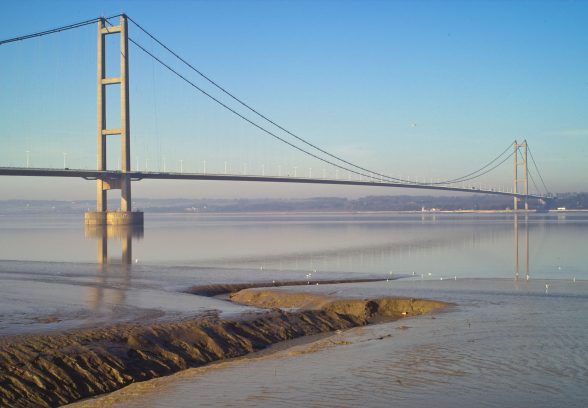This website uses cookies
This website uses cookies to enable it to function properly and to analyse how the website is used. Please click 'Close' to accept and continue using the website.



The Twentieth Century Society has welcomed Historic England’s decision to list the Humber Bridge at Grade I and the Hull Tidal Surge Barrier at Grade II but has voiced concerns about the ‘very real and on-going threat’ to other important historic buildings and works of art in the UK’s Capital of Culture, such as the Alan Boyson mural on the former BHS store that was turned down for listing earlier this year.
The Society submitted the Humber Bridge for listing in response to harmful plans earlier this year that proposed to turn the bridge into a visitor attraction. This would have involved fixing tracking, moving pods and viewing platforms to its monumental north tower. Historic England took forward the application and considered it alongside their assessment of the bridge as part of their City of Culture programme.
Designed by engineers Fox Freeman and Partners, it was the longest suspension bridge in the world when it opened to traffic in June 1981. It not only put into practice the revolutionary aerodynamic box girder concept but was also the first bridge in the world to adopt slip forming in the construction of the concrete towers. The Humber Bridge is arguably the most spectacular of Freeman Fox and Partner’s work in the post-war period due to its sheer height above the water and its elegant and distinct silhouette.
C20 also welcomed the Grade II listing of the Tidal Surge Barrier in Hull, built in 1977 to 1980 to designs by Oliver Cox of Shankland Cox with Sir M MacDonald & Partners as consulting engineers. It fulfils its role of flood prevention whilst also being sensitive to its location on the eastern edge of the Old Town where its sculptural arch enhances the lower stretch of the River Hull.
Tess Pinto, Conservation Advisor with C20 Society, said: “We are delighted that both the Humber Bridge and the Hull Barrier have been listed, giving national recognition to these magnificent feats of engineering.’
“At the same time we are being consulted on plans to demolish a landmark trawler fleet building in St. Andrew’s Dock Conservation Area. Surely in this year of all years we should be celebrating Hull’s nationally important cultural maritime heritage, not destroying it.”
Built in 1949, the Lord Line building has been locally listed by Hull City Council for its historic importance. It is the largest and most distinctive of the surviving fish dock buildings at St. Andrew’s Dock, home of the Hull trawler fleet from 1883 to 1975, originally serving as the office building for the Lord Line fleet owners and then later by other well-known local trawler companies. The proposed demolition is part of wider plans by a property group to clear the whole site, including the substantial demolition of the Grade II listed pump house (1870). No plans for redevelopment have been submitted.
Ms Pinto also highlighted the continuing threat to the “Three Ships” mosaic adorning the outside of the redundant BHS store in Hull, which is highly vulnerable to redevelopment. Designed by Alan Boyson, an influential post-war artist, at the time of its installation in 1963 was believed to be the biggest mural in Britain. Inside on the fourth floor is a smaller Fish Mural, depicting ceramic fish swimming in a tiled background of bubbling water, set between massive columns of kelp-like fronds in stone. C20 Society’s application to have the murals listed was refused, but the mural’s plight has been picked up by local campaigners who continue to fight for its protection.

Become a C20 member today and help save our modern design heritage.